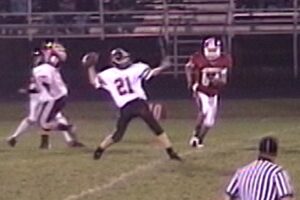Originally published in Wisconsin Agri-Business News – Winter 2018
How do you measure your salespeople?
How do you measure yourself?
“I wonder what they do all day. Who’s making sales calls and who isn’t?” says the general manager about his remote sales team.
“Bob is really doing great in his territory!” Says a manager who overly favors Bob.
“Barb has been selling for 30 years. I’m not going to tell her how to do her job.” Says a young manager who is intimidated by Barb’s experience.
“This is a people business. It’s not just about the numbers.” Says anyone who doesn’t want to be measured.
“I don’t have time to sit around and log every time I had a phone call with my customer. If Big Brother wants to know what I do, they can come ride with me.” Says a salesperson who is resisting the new CRM program or might not be doing their job.
Have you heard or maybe even said one of the comments listed above? Before we address them, let’s understand that measuring is a vital part of every business. Sales, especially is a very measurable part of our business. I am a big proponent of using these measurements, but only if done correctly. We can use measurements to monitor, motivate and make sense of the complex marketplace we operate in.
Most of us began our lives being measured in school by a report card. Then we graduate and find ourselves in a work world that has a lot of data, a lot of measurements and too often, very little training on how to use it. Every company and department have different measurements, which are calculated differently. It can be confusing, time-consuming and demotivating as you try to navigate the complexity of your company’s measurements.
Before we go any further, here is a great, time-saving tip. If you are measuring and not doing anything with that measurement, quit it! Kill the report, right now. Save yourself the wasted time of assembling that report. As a sales manager, one of the folks in the office approached me one day to talk about a report. She spent two hours a week compiling a report and sending it to a group of salespeople and managers. The report was terribly ineffective. So, I ignored it, as did most who received it. I thought the report was auto-generated and never realized someone was spending even five minutes assembling it. We killed the report immediately. After reading this article, your first step is to gather all your reports and spreadsheets. Find out how the data is gathered, who gathers it, how hard or long it takes to gather it and who is doing what with that information. Then challenge every one of those reports for validity and need.
When I’m brought in to work with a sales team, I tend to find salespeople and managers on one end of the spectrum with measuring. Either they are locked into “analysis paralysis” or they spend very little time analyzing the available data. Whichever end of the spectrum you are on, let’s dive into three ways you can use measurements in your role.
Monitoring
Just like a doctor monitors a patient’s vital signs (heart rate, blood pressure, body temperature), we need to monitor our territory and business’s vital signs. If we’re healthy, our doctor takes a quick glance at our vitals chart and moves on. Do the same with your monitoring measurements. However, the minute you start to see a change or erratic results, you can dig deeper into that area before it becomes a problem. Just like your doctor gives you treatment for blood pressure before your heart gives out, you pick up on changes in your business before they escalate into a problem.
Big Brother issues: This is an easy one to solve. If you are a manager and you feel the need to monitor your sales team’s activity to determine if they are “doing their job”, then you hired the wrong people. Or, you’re insecure about what it takes to sell. If so, consider a job change or bring someone in that can manage the sales team for you. If you are a salesperson and you are worried that Big Brother will see what you do, then you too should consider a career change. As a salesperson, I worked hard and felt I was doing everything in my power to sell as much as I could. I welcomed anyone in the company that could look at my activity/results and advise me on how to get better. Get beyond the big brother issue quickly by measuring to improve.
What to monitor and why?
- Results: Dollars and units sold on every territory, customer and product line. Since agribusiness is so seasonal, these need to be measured both monthly and year-to-date using six Excel columns. The first three are monthly results: this month, this month last year and a column for the variance (up or down versus last year). The next three columns are for annual results: Year to date, last year to date and a column for the variance (up or down versus last year). Next on our list of measurements is Accounts Receivables (A/R): Yes, the dreaded A/R report. As salespeople we dread it. However, keep in mind that if you sell and don’t get paid, technically that’s called donating. Whether you collect it yourself or not doesn’t matter. It’s your customer and you got the company involved with them. You need to see it through to payment.
- Segmented results: Now take those results and break them into thirds. Often called the ABC method. Who are my A accounts (top third)? B accounts (middle third)? C accounts (bottom third)? I like to do this both by units and by dollars to see if they are in alignment or not. If not, why?
- Activities:
- Sales calls: Write down how many times you called on each customer in the last 6 months or year. Then sort your list by ABC. Does your number of sales calls coincide with your ABC segments? In other words, are you spending more time with your top accounts? This activity is for the salesperson to do and work through with their manager. I don’t believe it’s helpful to go any higher in the organization. I consulted with a company that monitored the number of sales calls per salesperson at the national level. While that’s ok if you are using it to determine success patterns or overall activity, it’s not ok to identify inactivity by specific salespeople. If you do, salespeople will give you the results you are looking for: more sales calls in this example. However, they may not be effective sales calls.
- Capacity: This is an overlooked area that I focus on when coaching or consulting. What is the ideal, typical or expected number of customers per salesperson, and annual dollars/units of sales per salesperson? How many dollars or units in sales does it take to breakeven over the cost of a salesperson? Where is each salesperson in relation to that standard or expectation?
- Customer turnover: This helps determine if you are losing more customers than you are adding. Critical in diagnosing the selling process.
- New accounts: This is one more vital sign that paints the picture of your sales team and your territory health.
Motivating
Top performing salespeople have a burning desire to succeed. They want to know what the goal is and where they are at on reaching that goal. Therefore, it’s important to provide this motivation tool.
- Progress Thermometer: Ever see one of those giant cardboard thermometers that charities use to color in as donations come in? You can see the goal of $1000 with the thermometer marked off in $100 increments. It generates excitement and creates awareness. Effort increases as you get closer and closer to the end. As a sales manager, this is the same motivating environment you create when you bring up the sales team’s goals and update them as the year progresses. Often, teams are presented with the yearly goal via the annual business plan and then never see it again until the annual meeting. If you took the time to create the goal, take the few extra minutes to measure the sales team’s progress towards achieving that goal.
- Calorie Counter Mentality: In personal fitness, there are many sports apps that help you record your diet and exercise. They are much more accurate than estimating, guessing or worse yet, not counting them at all. It’s this immediate feedback that tells you whether or not you had a good or a bad fitness day. You can make modifications in your diet or exercise right away. Same goes for motivating yourself to stay on your good work habit routines when it comes to selling. Measuring the number of sales calls, the number of prospect calls, the number of times you did a pre-call plan and developed an agenda for your sales call, the number of open-ended questions you are asking on sales calls, the percent of your sales calls that you asked a closing style question, the percentage of time that you are talking on your sales calls versus your customer talking, etc. These are great immediate feedback measurements to help improve your selling skills.
- Fairness: I know life is not fair, but measuring results can bring fairness to your sales team and your customers. We’ve all heard the phrase, “the squeaky wheel gets the grease”. This can be so true with sales teams and customers. Often, it’s the most talkative or influential salesperson that gets their way. Ever sit in a meeting and hear a salesperson dominate the conversation? And then realize they don’t have the results to back up their opinions. I have seen companies launch products based on one of these louder salespeople saying, “We could sell a lot of that product if we stocked it in the warehouse!” Only to see that product come in and go into the dumpster 3 months later. Likewise, I have seen salespeople focus the majority of their time on the squeaky wheel customer. Don’t get caught up in the noise of the loudest customer in your territory and lose track of where your revenue is coming from. Measuring results by salesperson and customer helps us validate our use of time and resources.
Making Sense
Measuring helps us make sense of our business, our sales process and how we manage our resources. By segmenting customers based on results (dollars and units), we can determine who is generating the majority of our revenue, when they are generating that revenue and which products are generating the revenue. This helps a salesperson allocate time and resources. In a world where everyone feels they are overwhelmed to get it all done, segmenting customers and prospects helps you focus on the right ones.
Measuring promotions and seasonal results will help determine what is working and what isn’t. Trade shows are not cheap. So, knowing which ones provide leads and prospects is important to measure when determining which shows you should attend.
Measuring prospects throughout their journey in the prospect funnel is critical to identifying where you are effective versus losing the sale. Often, the prospect funnel starts with the marketing department’s social media campaign. From there, the prospect winds their way through email/phone call contact with the sales team, farm calls, sales presentations and ultimately become a customer or drop off the radar. Measuring where this happens is important for companies to improve their results.
I’ll leave you with a couple last tips on measuring:
- What gets measured, gets done: The second part of that is, “be careful what you measure because you just might get it.” Remember that company I mentioned that focused on measuring the number of sales calls their remote sales team was making on farmers. These numbers were monitored and discussed across the whole company. Guess what they got. The sales team figured this out and logged sales calls. They didn’t hit their sales results, but they were making sales calls. That measurement should have gone no higher than the first line sales manager.
- Make it quick, easy and use your CRM program: Look around your company today! Ask your sales team and sales managers how much time they are spending on reports. If they are spending an inappropriate amount of time putting data together and building reports, get it out of their hands and make it quicker for them. In today’s world, where people know how to build complex Excel or Tableau spreadsheets, charts and graphs, don’t allow your sales team or managers to struggle through this every week or month. I’m not saying they are above learning how to work with Excel. I’m saying, set it up so it’s point-and-click. The best way to do that is to tie your data into your CRM program. Then build them a simple dashboard for real-time updates. Now, you have a great tool that a salesperson can use to monitor their own performance.
- By “easy”, I mean make it crystal clear on how the measurement is determined. If there is gray area or disagreement around how the measurement is determined, either fix it or remove the measurement. Poor measurements are worse than no measurement. Many times, I see a company using a chart or graph, only to find out from the sales manager that the chart results are highly questionable. They have to then explain the measurement to their sales team when it comes out from the main office.
Sales measurements are great for monitoring, motivating and making sense of your territory and market place. It just takes a little time to think through how you set them up and who uses them. Additionally, you need to review them at least annually to make sure they are still effective and helpful.
For more information on Ag sales training, coaching or business development, contact Greg Martinelli at Ag Sales Professionals, LLC at (608) 751-6971. Email is Greg@GregMartinelli.net Web site is www.GregMartinelli.net





